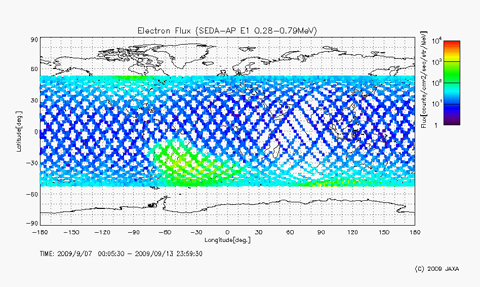This is an archive of information released in the past.
Disclaimer: It may contain broken links or outdated information. Some parts may not function in current web browsers.
*Visit https://humans-in-space.jaxa.jp/en/ for the latest information.

Experiment
- News
- Kibo Utilization Strategy
- Kibo Utilization Plan
- List of JAXA's Utilization Themes
- Experiment Facilities
- Space Environment Utilization
- Archive
SEDA-AP Began Nominal Operations
* Dates and times are given in Japan Standard Time (JST)
The Space Environment Data Acquisition equipment - Attached Payload(SEDA-AP) successfully completed initial checkouts and entered into its nominal operations phase.
The SEDA-AP was launched and installed on Kibo's Exposed Facility (EF) during the STS-127 (2J/A) Mission. From August 4, 2009, a series of checkouts on the common bus equipment (electrical and communications systems) and the mission equipment have sequentially been conducted with commands sent from the Tsukuba Space Center (TKSC).
After analyzing and evaluating the initial checkout data, the SEDA-AP team confirmed that each common bus equipment and mission equipment onboard the SEDA-AP functioned just as expected. In September 17, the SEDA-AP began space environment measurements using its eight on-board mission devices.
The SEDA-AP is designed to perform eight observation activities simultaneously using eight on-board mission devices. The SEDA-AP will be operated for three years aboard the ISS, which flies at an altitude of approximately 400km above the earth. The SEDA-AP is also designed to accommodate space particle capturing devises and material exposure experiments; these experiments will return to the ground in eight months for sample recovery.
Data measured by the SEDA-AP will be utilized as basic information for designing spacecrafts and their onboard equipment, and also used for developments of new spacecraft materials. Using these data, safety measures for catastrophic accidents in space caused by spacecraft's anomalies, and or countermeasures for space radiation exposures can be established for future space explorers.
Electron (0.28-0.79MeV) measured by the SEDA-AP's SDOM was mapped on a world chart. Higher energy radiation is measured in the South America region (called South Atlantic magnetic anomaly zone or SouthAtlanticAnomaly (SAA) because of its strong magnetic radiation related to geomagnetism) and vertical-latitude areas (the area within the outer belt of the radiation belts).
Comments from the Principal Investigator, Tateo Goka (JAXA Aerospace Research and Development Directorate)
Initial checkouts of the SEDA-AP were completed, and results of the checkouts were reviewed at the JAXA's review board meeting on September 17, 2009. In the review, the SEDA-AP was approved for nominal operations. Being the principal investigator (PI) of the SEDA-AP project, I was very excited when the SEDA-AP entered its nominal operations phase.
However, it is just a beginning. The SEDA-AP will continuously monitor space environment around the ISS orbit where Japanese astronauts will stay on long-duration missions. The SEDA-AP will perform long-term monitoring on neutrons and other radiation environment, plasma environment and electrostatic potential, atomic oxygen environment, cosmic dust and micro debris environment around the ISS. Also the SEDA-AP will investigate effects of those environments on spacecraft components and materials.
So far, all of our milestones were accomplished with no major issues. This is thanks to the people at JAXA, NASA and from other industries, co-investigators of the SEDA projects and all the people supporting us. We deeply appreciate those supports, and determined to achieve fruitful outcome for space science and space technology in order to meet expectations.
*All times are Japan Standard Time (JST)
| Copyright 2007 Japan Aerospace Exploration Agency | Site Policy |
